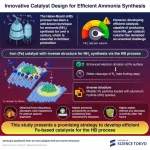(Press-News.org) During the COVID-19 pandemic, when fentanyl overdoses surged, doctors were desperate to find ways of helping their patients.
They knew that buprenorphine could help people stop using opioids, but it was much harder to start the treatment for those who used fentanyl, which lasts longer in the body. Taking buprenorphine while fentanyl is still active can push someone abruptly into withdrawal.
So, they started giving patients small doses of the drug over a series of days to slowly build up the drug in their systems until their bodies could handle a higher dose of buprenorphine.
Now, doctors at UC San Francisco have tested this microdosing approach, known as low-dose initiation, and found that most of the time it does not work. Of 126 participants, just 34% were able to work up to a full dose of buprenorphine using this new approach.
Leslie W. Suen, MD, MAS, the study’s first author, said she was disappointed by the results but the findings need to be shared.
“This doesn't seem like it’s working the way we had hoped,” said Suen, an assistant professor at the UCSF Division of General Internal Medicine and an addiction medicine specialist. “But when people expect it to work, and it doesn’t work for them, they feel like there’s something wrong with them.”
The study, the largest evaluation of low-dose buprenorphine initiation, appears in JAMA Network Open on Jan. 24.
Buprenorphine is the most widely used of the three drugs that are approved to treat opioid use disorder. Other treatments include methadone, which is dispensed through certified treatment clinics, and injectable naltrexone, a longer-acting treatment that is prescribed when a person is no longer physically dependent on opioids.
Although buprenorphine is proven effective, the drug is largely underutilized due to a range of issues, including a dearth of physicians trained to prescribe the medication, insurance issues and stigma.
Buprenorphine is what’s known as a partial opioid agonist, meaning that it works by only partly binding to the receptor that creates the “high” without offering the level of euphoria of stronger opioids.
The promise of low-dose initiation
Before the introduction of fentanyl, buprenorphine had higher success rates, but starting it often meant that people had to stop their opioid use and experience some withdrawal before taking it. If people had opioids in their bodies and took buprenorphine, they could experience extreme worsening of their withdrawal from the buprenorphine. Because heroin and other opioids leave the body predictably, starting buprenorphine was easy. People could stop their opioids, wait several hours, and then start buprenorphine.
But fentanyl is stored longer in the fat cells, and it’s harder to predict how long it takes to leave the body. People would stop their opioid use and wait the appropriate amount before starting buprenorphine, but they would still experience precipitated withdrawal from fentanyl. Doctors hoped that slowly introducing the buprenorphine would help reduce the discomfort, and people could stop using fentanyl when they felt ready or once the buprenorphine got to a good dose.
The participants were treated at two outpatient substance-use disorder clinics in San Francisco between May 2021 and November 2022. They opted either for seven days of taking low doses of buprenorphine before getting up to an optimal dose (dosing two or three times a day), or four days of treatment (dosing four times a day). Taking different doses can be confusing, so the researchers gave them the medication in a bubble pack to help them manage their treatment.
At follow-up visits, 38% of those with the four-day regimen achieved successful buprenorphine initiation and 28% were successful on the seven-day protocol, for an overall success rate of 34%. Overall, 22% stayed on the drug for at least 28 days. Repeated attempts yielded lower rates of success than the first attempt.
Suen said the findings indicate that more options are needed to support people initiating buprenorphine. She and her fellow researchers are already involved in a follow-up study to determine why this promising approach is proving to be less effective than hoped.
Authors: Additional UCSF authors include Amy Y. Chiang, PhD, Hannah R. Snyder, MD, John Neuhaus, PhD, Janet M. Myers, PhD, Kelly R. Knight, PhD, and Alexander R. Bazazi, MD, PhD.
Funding: The study was funded by the Agency for Healthcare Research and Quality (grant K12HS026383) and the National Institute on Drug Abuse (grants 1K23DA060329 and 2K24DA042720). See the study for disclosures.
About UCSF: The University of California, San Francisco (UCSF) is exclusively focused on the health sciences and is dedicated to promoting health worldwide through advanced biomedical research, graduate-level education in the life sciences and health professions, and excellence in patient care. UCSF Health, which serves as UCSF's primary academic medical center, includes top-ranked specialty hospitals and other clinical programs, and has affiliations throughout the Bay Area. UCSF School of Medicine also has a regional campus in Fresno. Learn more at ucsf.edu, or see our Fact Sheet.
###
Follow UCSF
ucsf.edu | Facebook.com/ucsf | YouTube.com/ucsf
END
Doctors test a new way to help people quit fentanyl
Buprenorphine works for opioid use disorder. But a new way of starting it using small doses seems less effective, UCSF study finds.
2025-01-24
ELSE PRESS RELEASES FROM THIS DATE:
Long read sequencing reveals more genetic information while cutting time and cost of rare disease diagnoses
2025-01-24
One in every 10 people worldwide is impacted by a rare genetic disease but about 50% of them remain undiagnosed despite rapid increases in genetic technology and testing. Even when a person does have access to testing, the process of getting a diagnosis can take about five years or more, which is sometimes too late for patients, who are often children, to start the right treatment.
This is partly because current clinical testing uses a method called short-read sequencing, which cannot access information in certain regions of the genome and so may miss ...
AAAS and ASU launch mission-driven collaborative to strengthen scientific enterprise
2025-01-24
Today, the American Association for the Advancement of Science and Arizona State University announced a five-year partnership, the AAAS + ASU Collaborative. Together, the institutions will elevate and amplify strategies and practices that advance scientific excellence and enable a boldly inclusive scientific enterprise serving society.
In its first phase, the Collaborative includes a joint prize, an invitation for the ASU STEMM community to join AAAS as Elemental Members, and events in Washington, D.C., addressing policy-relevant science topics.
“Focusing science and scientific advances on the challenges we face is essential to the advancement ...
Medicaid-insured heart transplant patients face higher risk of post-transplant complications
2025-01-24
A new study led by UCLA Health highlights the link between socioeconomic disadvantage, Medicaid insurance, and poorer survival rates after heart transplantation. Researchers found that Medicaid-insured heart transplant patients had a higher likelihood of developing cardiac allograft vasculopathy (CAV), a condition that affects transplanted hearts and can limit long-term survival. It has been reported that CAV contributes to more than 30% of all deaths in the first 5 to 10 years following heart transplantation.
The study, which included heart transplant recipients aged 18 and older, divided ...
Revolutionizing ammonia synthesis: New iron-based catalyst surpasses century-old benchmark
2025-01-24
NH3 is one of the most important chemicals in today’s world, as it is used in the production of fertilizers to boost agricultural yields and sustain the ever-growing global population. For over 100 years, NH3 production has relied on the Haber–Bosch (HB) process, which combines nitrogen (N2) and hydrogen in the presence of a catalyst. Interestingly, an iron-based catalyst developed a century ago (called ‘Promoted-Fe’) still remains at the forefront of mass NH3 production, despite countless efforts to find more energy-efficient alternatives. In the HB process, where NH3 is produced by a catalyst-filled reactor with a limited volume, ...
A groundbreaking approach: Researchers at The University of Texas at San Antonio chart the future of neuromorphic computing
2025-01-24
A review article about the future of neuromorphic computing by a team of 23 researchers, including two authors from UTSA, was published today in Nature. Dhireesha Kudithipudi, the Robert F. McDermott Endowed Chair in Engineering and founding director of MATRIX: The UTSA AI Consortium for Human Well-Being, served as the lead author, while Tej Pandit, a UTSA doctoral candidate in computer engineering, is one of the co-authors. The review article, titled “Neuromorphic Computing at Scale,” examines the state of neuromorphic technology and presents a strategy for building large-scale neuromorphic systems.
The research is part of a broader effort ...
Long COVID, Italian scientists discovered the molecular ‘fingerprint’ of the condition in children's blood
2025-01-24
One day Long Covid in children could be objectively diagnosed with a blood test, thanks to the help of Artificial Intelligence (AI). In fact, a study by the Università Cattolica del Sacro Cuore, Rome campus - Fondazione Policlinico Universitario Agostino Gemelli IRCCS and the Ospedale Pediatrico Bambino Gesù IRCCS, has highlighted the molecular signature of Long Covid in plasma in paediatric age and used an AI tool capable of making the diagnosis based on the results of the blood sample, with 93% ...
Battery-powered electric vehicles now match petrol and diesel counterparts for longevity
2025-01-24
Battery-powered electric vehicles are now more reliable and can match the lifespans of traditional cars and vans with petrol and diesel engines - marking a pivotal moment in the drive towards sustainable transportation, a new study reveals.
Researchers used nearly 300 million UK Ministry of Transport (MOT) test records charting the ‘health’ of every vehicle on the United Kingdom’s roads between 2005 and 2022 to estimate vehicle longevity and provide a comprehensive analysis of survival rates for different powertrains.
The international research ...
MIT method enables protein labeling of tens of millions of densely packed cells in organ-scale tissues
2025-01-24
A new technology developed at MIT enables scientists to label proteins across millions of individual cells in fully intact 3D tissues with unprecedented speed, uniformity, and versatility. Using the technology, the team was able to richly label whole rodent brains and other large tissue samples in a single day. In their new study in Nature Biotechnology, they also demonstrate that the ability to label proteins with antibodies at the single-cell level across whole brains can reveal insights left hidden by other widely used labeling methods.
Profiling the proteins that cells are making is a staple of studies in biology, neuroscience and related fields because the ...
Calculating error-free more easily with two codes
2025-01-24
Computers also make mistakes. These are usually suppressed by technical measures or detected and corrected during the calculation. In quantum computers, this involves some effort, as no copy can be made of an unknown quantum state. This means that the state cannot be saved multiple times during the calculation and an error cannot be detected by comparing these copies. Inspired by classical computer science, quantum physics has developed a different method in which the quantum information is distributed across several entangled quantum bits and stored redundantly in this ...
Dissolving clusters of cancer cells to prevent metastases
2025-01-24
Certain tumour types do not remain at their point of origin but spread throughout the body and form metastases. This is because the primary tumour continuously releases cancer cells into the blood. These circulating tumour cells (CTCs) can join together into small clusters of up to a dozen cells and settle in other organs. There, the clusters grow into larger tumours, known as metastases. Metastatic tumours are still a major medical problem: every year, around seven million people worldwide die from them.
One example of such a spreading tumour is breast cancer. As soon ...
LAST 30 PRESS RELEASES:
American Meteorological Society announces Rick Spinrad as 2026 President-Elect
Biomass-based carbon capture spotlighted in newly released global climate webinar recording
Illuminating invisible nano pollutants: advanced bioimaging tracks the full journey of emerging nanoscale contaminants in living systems
How does age affect recovery from spinal cord injury?
Novel AI tool offers prognosis for patients with head and neck cancer
Fathers’ microplastic exposure tied to their children’s metabolic problems
Research validates laboratory model for studying high-grade serous ovarian cancer
SIR 2026 delivers transformative breakthroughs in minimally invasive medicine to improve patient care
Stem Cell Reports most downloaded papers of 2025 highlight the breadth and impact of stem cell research
Oxford-led study estimates NHS spends around 3% of its primary and secondary care budget on the health impacts of heat and cold in England
A researcher’s long quest leads to a smart composite breakthrough
Urban wild bees act as “microbial sensors” of city health.
New study finds where you live affects recovery after a hip fracture
Forecasting the impact of fully automated vehicle adoption on US road traffic injuries
Alcohol-related hospitalizations from 2016 to 2022
Semaglutide and hospitalizations in patients with obesity and established cardiovascular disease
Researchers ‘listen in’ to embryo-mother interactions during implantation using a culture system replicating the womb lining
How changing your diet could help save the world
How to make AI truly scalable and reliable for real-time traffic assignment?
Beyond fragmented markets: A new framework for efficient and stable ride-pooling
Can shape priors make road perception more reliable for autonomous driving?
AI tracks nearly 100 years of aging research, revealing key trends and gaps
Innovative techniques enable Italy’s first imaging of individual trapped atoms
KIER successfully develops Korea-made “calibration thermoelectric module” for measuring thermoelectric device performance
Diversifying US Midwest farming for stability and resilience
Emphasizing immigrants’ deservingness shifts attitudes
Japanese eels, climate change, and river temperature
Pusan National University researchers discover faster, smarter heat treatment for lightweight magnesium metals
China’s 2024 Gastroenterology Report: marked progress in endoscopy quality and disease management
Pusan National University researchers uncover scalable method for ultrahigh-resolution quantum dot displays
[Press-News.org] Doctors test a new way to help people quit fentanylBuprenorphine works for opioid use disorder. But a new way of starting it using small doses seems less effective, UCSF study finds.




